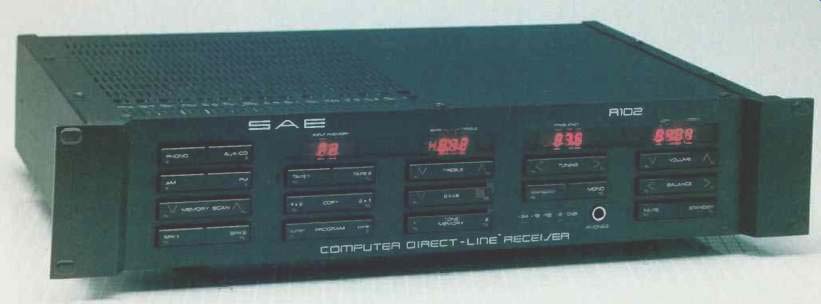
Manufacturer's Specifications:
FM Tuner Section
Usable Sensitivity: Mono, 11.2 dBf; stereo. 17.2 dBf.
50-dB Quieting Sensitivity: Mono, 14.4 dBf; stereo. 35.8 dBf.
S/N: Mono, 75 dB; stereo, 70 dB.
THD (At 1 kHz): Mono, 0.10%;stereo, 0.15%.
Selectivity: 30 dB.
Capture Ratio: 17 dB.
Image Rejection: 78 dB.
Rejection: 88 dB.
Spurious Rejection: 88 dB.
AM Suppression: 55 dB.
Separation: 50 dB at 1 kHz; 40 dB from 100 Hz to 10 kHz.
Frequency Response: 40 Hz to 15 kHz, ± 1.5 dB.
AM Tuner Section
Usable Sensitivity: 15 V.
S/N: 50 dB.
Selectivity: 32 dB.
THD: 0 If. Rejection: 10 dB.
Image Rejection: 45 dB.
Amplifier Section
Power Output: 50 watts per channel, 8 ohms, 20 Hz to 20 kHz.
THD: 0.025%
SMPTE-IM Distortion: 0.035%.
Dynamic Headroom: 0.2 dB.
Damping Factor: 30.
Input Sensitivity: Phono, 2.5 mV; high level, 150 mV (for rated power).
Frequency Response: Phono, RIAA ± 0.25 dB; high level, 10 Hz to 100 kHz, +0,-2.5 dB.
S/N: Phono (re: 2.5-mV input), 82 dB; high level (re: 1-watt output), 77 dB.
Tone Control Range: Bass, ± 10 dB at 100 Hz; treble, ± 10 dB at 10 kHz.
General Specifications
Dimensions: 19 in. (48.3 cm) W x 3.5 in. (8.9 cm) H x 14 in. (35.6 cm) D.
Weight: 22 lbs. (11 kg).
Price: $499.00.
Company Address: 1734 Gage St., Montebello, Cal. 90640.
The trend towards knobless audio products continues, SAE's new R102 integrated receiver sports not a single rotary knob on its front panel, and the result, in my opinion, is a clean-looking, easy-to-operate unit that would fit nicely into any mid-priced home audio system. This is partially made possible by a design concept which SAE calls Direct-Line Audio. It uses an on-board microprocessor/computer to make front-panel layout independent of the audio circuits' locations in the chassis. As SAE puts it, "This approach frees both the audio engineer and the front-panel designer to optimize their respective areas." In the R102, almost all controls have been grouped ac cording to their function, with alphanumeric or digital read outs for each group. Input selectors cluster around an alphanumeric display showing which signal source (and, in tuner mode, which station memory) is selected. Tone functions (including a memory selector that lets you return to either of two favorite bass and treble settings instantly) line up beneath a digital display which shows the degree of bass and treble cut or boost. Most tuning controls lie just under the digital tuning display (the exception, a rocker which scans up or down through the eight-station memory on each radio bard, is grouped with the input selectors).
And a digital display showing volume settings for each channel sits above the buttons and switches for all volume-related functions. All controls whose action is not shown in the main displays have indicator LEDs, so control settings can be taken in at a glance.
My overall impression of the front panel's layout is that it may be too "computerized" for those who belong to the inveterate knob-twirler school of audio appreciation. On the other hand, those whose interest is primarily in listening to good music will appreciate the ease with which this receiver's controls perform. Many people will love it; a few will feel it takes some of the fun out of using the equipment.
Control Layout
A detailed description of the front-panel control layout will show you what I mean. Six touch pads and a double-width rocker pad are found at the left end. Four of these light-touch buttons or pads are used to select program input sources ("Phono," "AUX/CD." "AM" or "FM"). According to SAE, changing input selections makes the receiver's micro processor ramp the volume first down, then up again, for a fast cross-fade effect, visible on the volume display across the panel. I didn't notice this, probably because the owner's manual hadn't alerted me to look for it.
Below the input selectors come the switches which select main or remote speaker output. Separating these input and output functions is a double-width "Memory Scan" rocker, which accesses the eight station memories. A single touch of the appropriate end of the bar retunes to the next or previous memory; holding down the bar continues the scan to more distant memory numbers.
There are a total of four displays arranged in pairs across the upper section of the panel. The display closest to the controls just described shows which program source has been selected ("F' for FM, "A" for AM, "AU" for AUX and "PH" for phono), and, when the memory scan bar is de pressed, it shows which of the eight memorized frequencies has been called up (e.g.. "F2," "A6," etc.). Below this display are "Tape " and "Tape 2" touch bars (for selecting either of the tape monitor loops), a tape 1-to-2 or tape 2-to-1 "Tape Copy" rocker switch pad, and another rocker pad which programs the tuner and tone memories. Pressing this pad starts an LED flashing; calling up the appropriate memory (and. for station memory. pressing "Program" again) makes the memory entry and extinguishes the LED.
To the right of this cluster, and below the second display area, are treble and bass rocker touch bars and a bar labeled "Tone Memory." Pressing either end of this bar after pressing the "Program" bar memorizes control settings, while pressing the memory bar alone recalls the memorized tone setting. (Memory 1 comes factory-programmed for loudness compensation at a fixed level.) The display above the control bars shows the settings of the Baxandall tone control circuits, in 2-dB steps of boost or cut (e.g., "06:04" means 6 dB of bass and 4 dB of treble boost or cut-the display doesn't tell you which).
The next display, further to the right near the top edge of the panel, shows AM or FM tuner frequencies. Below this readout are a "Tuning" rocker bar, a "Manual" touch bar (which overrides the automatic tuning mode to allow tuning in single-frequency steps), a mono/stereo touch bar (which, in mono, also defeats FM muting), and. near the lower edge of the panel, two sets of level-indicating LEDs calibrated in 6-dB increments from "0 dB" to "- 24 dB." The "0 dB" LED corresponds approximately to full power output and is red to warn of approaching amplifier overload or clipping.
The display on the far right shows output-level settings for each channel in dB. Unequal readings (such as "54:56") indicate that the balance control is not centered. Beneath the display are the "Volume" and "Balance" rocker bars, which adjust listening levels in 2-dB increments for each touch, or in 4-dB increments if held continuously.
At the bottom are switch pads for audio "Mute" and "Standby." The muting function decreases volume by the usual 20 dB-but volume can only be decreased, not in creased, while the muting is on. This prevents sudden ear-blasting, speaker-blowing jolts of sound when it is switched off again. The "Standby" switch turns off all audio circuits and controls but leaves the microprocessors and associated memories alive until the unit is turned on again.
The rear panel of the R102 is equipped with the usual 75- and 300-ohm FM, and external AM, antenna terminals. An AM loop antenna, located at the center of the rear panel, can be detached and mounted remotely to further improve reception. "Phono,' "AUX," "Tape 1" and "Tape 2" jacks as well as a ground terminal are provided, as are two sets of polarity-identified loudspeaker terminals, two switched a.c. convenience outlets, and a 5-ampere line fuse.
SAE's owner's manual, though succinctly adequate thanks to its use of graphics and illustrations, tells us little about the R102's circuitry. A brief press release concerning this receiver informs that the audio circuits "utilize SAE's latest technology, including the Phono Power Amp, and High Current main power amplifier." So much for circuit details.
Tuner Measurements
The most outstanding characteristics of the R102's FM tuner section, considering its relatively modest price, are its low distortion in both mono and stereo, its high signal-to noise ratios, and its excellent stereo separation characteristics. Somewhat less impressive are such secondary, but important, characteristics as AM suppression and alternate-channel selectivity.
Figure 1 shows FM quieting and THD (at a 1-kHz modulating frequency) in both mono and stereo modes. Best quieting with strong signals measured 80 dB in mono and 77 dB in stereo, both figures well above SAE's conservatively stated claims. Harmonic distortion in. mono measured only 0.05% at 1 kHz, increasing to a still insignificant 0.08% in stereo. Usable sensitivity in mono was 12.0 dBf, while in stereo I measured a least usable sensitivity of 20 dBf. The switchover point from mono to stereo occurs at an even lower input level of 15 dBf, but, of course, the signal is then quite noisy and unusable. Fifty-dB quieting for mono measured 15 dBf; for stereo, the 50-dB quieting point was reached with an input signal strength of 35 dBf.

Fig. 1--Mono and stereo FM quieting and distortion characteristics.
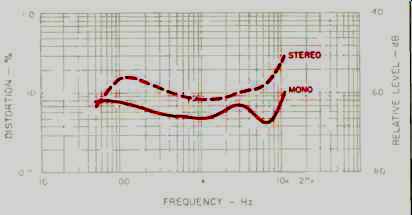
Fig. 2--Distortion vs. frequency, FM section.
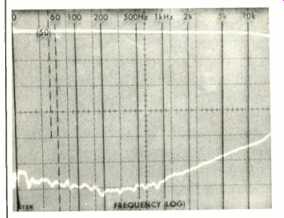
Fig. 3-Response (top trace) and stereo separation vs. frequency, FM section.
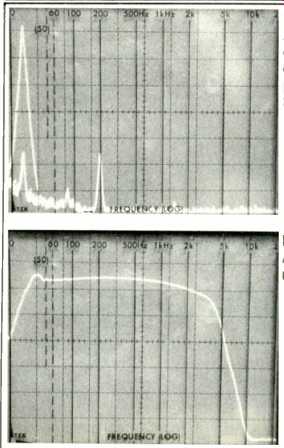
Fig. 4--Analysis of 5-kHz crosstalk and distortion products, FM section.
Fig. 5--AM frequency response.
Figure 2 is a plot of THD versus modulating frequency for both mono and stereo operation. Unlike many inferior stereo decoding circuits, the multiplex decoder section of this FM tuner circuit did not produce high levels of "beats" when high audio frequencies modulated the carrier. This is evidenced by the low reading of THD at 10 kHz in the stereo mode.
Figure 3 is a plot of FM tuner-section frequency response (in stereo) and separation. Frequency response was flat within 0.5 dB from 30 Hz to 10 kHz, but it was down about -2.0 dB at the upper FM broadcast limit of 15 kHz. At the three key test frequencies of 1 kHz, 100 Hz and 10 kHz, I measured separations of 51.5, 50 and 40 dB, respectively.
Figure 4 illustrates the excellent crosstalk characteristics of the multiplex decoder section. The tall spike at the left of this spectrum-analyzer scope photo represents the desired left-channel output of a 5-kHz. 100%-modulated stereo signal, while the shorter spike contained within it represents the amplitude of 5-kHz output from the unmodulated right channel. More important, while there is evidence of 19-kHz output, there are virtually no visible crosstalk or distortion products seen at the unmodulated channel's output.
Alternate-channel selectivity measured 45 dB, and cap ture ratio measured 2.0 dB. Spurious and i.f. rejection were both around 90 dB, with image rejection measuring close to 80 dB. AM suppression was exactly 55 dB, as specified.
The AM tuner section performed pretty much as claimed.
Frequency response for AM, shown in the spectrum-analyzer 'scope photo of Fig. 5, turned out to be better than most.
Although amplitude begins to roll off above 2 or 3 kHz, there is still a fair amount of output at and above 5 kHz: the bass end of the response curve is relatively flat to below 50 Hz.
Amplifier Measurements
The power amplifier of the R102 was able to deliver 56.7 watts per channel, at 1 kHz with both channels driven into 8-ohm loads, at the rated harmonic distortion level of 0.025%.
At 20 kHz, maximum power output for that THD level was 53.5 watts; at 20 Hz, it was 51.8 watts. At rated output (50 watts per channel), THD for a 1-kHz test signal measured 0.01%. SMPTE IM at rated output measured 0.02% (as claimed), CCIF (twin-tone) IM measured a very low 0.0022%, and IHF IM was below my test equipment's ability to read it (well under 0.03%). Figure 6 is a graph of power output versus harmonic distortion for three key test-signal frequencies. I also operated the amplifier section with 4-ohm loads, and at that lower load impedance, the amplifier was able to produce 70 watts of power per channel at mid-frequencies and 65 watts per channel at the audio-frequency extremes for a distortion level of 0.025%. SAE might well have quoted power output for this impedance in their FTC disclosure, since the amp has plenty of current supply capability for this and for even lower impedances. SMPTE-IM distortion at 50 watts equivalent output using the 4-ohm loads measured 0.02%, the same as for 8 ohms.
Damping factor, using a 50-Hz signal and 8-ohm loads, measured 47 as against only 30 claimed by SAE; perhaps SAE used a different reference frequency in their measurement of this parameter. The amplifier has very little dynamic headroom, approximately 0.3 dB by my measurement method as against SAE's claim of an even lower 0.2 dB. This indicates a stiff power-supply configuration, not a design flaw, and it merely means that under music program conditions you should not expect to obtain much more than the 50 watts of power that is measured with continuous test signals. It also means that if you are going to use any of the wide-dynamic-range program sources now available (CD player, Beta Hi-Fi VCR, VHS Hi-Fi VCR, or even some digitally mastered phonograph records), you will want to link the R102 up to a pair of fairly high-efficiency speakers.
Figure 7 is a multiple-sweep logarithmic frequency plot (from 20 Hz to 20 kHz) showing the maximum boost and cut range of the bass and treble tone controls. These nicely configured circuits leave the mid-frequencies pretty much intact even when maximum bass and treble cut or boost is applied to the audio frequency extremes, just the way a good set of tone controls should operate.
Input sensitivity for the phono inputs was 0.4 mV for 1-watt output, with volume control set at maximum. Under the same test conditions, 20 mV was required at the high-level inputs to produce 1 watt of power into 8-ohm loads. Phono overload measured, a surprisingly low 70 mV. SAE offers no published specification for these important characteristics, but my test results suggest that you had better go for a relatively low-output moving-magnet phono cartridge if you are going to use this receiver. Otherwise, some of the newer digitally mastered or direct-to-disc LPs in your collection may well overdrive the phono preamp stages during musical peaks.
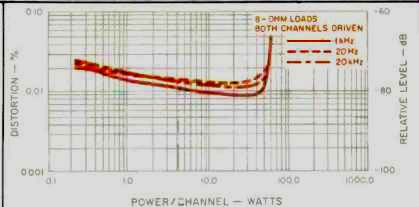
Fig. 6--Harmonic distortion vs. power.
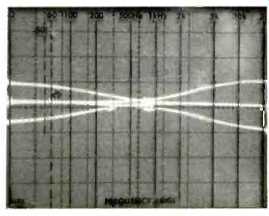
Fig. 7--Range of bass and treble tone controls.
Maximum deviation from precise RIAA equalization was about +0.4 dB over the bass region and -0.5 dB at 15 kHz. Phono S/N measured a very high 85 dB, referred to 5-mV input and 1-watt output; for the high-level inputs, S/N measured 81 dB with reference to a 0.5-V input and 1-watt output. At minimum volume, residual hum and noise was 99 dB below 1-watt output or, if referred to rated output, it was -116 dB!
Overall frequency response from a high-level (AUX) input to speaker outputs was flat from 5 Hz to 40 kHz, + 0,-1.0 dB; for a -3 dB cutoff point, response extended from 3 Hz to 100 kHz. The receiver consumes around 135 watts when idling and a maximum of 300 watts with both channels delivering full power.
Use and Listening Tests
My concern regarding the power output and dynamic headroom capabilities of this small receiver were reinforced when I began my listening tests. Hoping at first to listen via my usual reference speakers (a pair of KEF 105.2 units), I soon abandoned that idea. Those speakers were adequate for listening to FM and most of the preferred LPs in my record collection. However, when I attempted to listen to some of my newest and best CDs, the R102 ran out of steam and I could see the red LEDs on the receiver's front panel flashing repeatedly as I tried to achieve the kind of lifelike levels I enjoy. To be sure, the overload only occurred during musical crescendos, but it was sufficiently audible to make me switch to my alternate reference speakers. B & W Model 3000 units, which are several dB more sensitive than the admittedly low-efficiency KEFs. That difference was enough to keep the amplifier section of the R102 from going into clipping on peaks at the same listening levels as before.
I don't want to overemphasize this problem. There are any number of speakers available which, when teamed with an honest 50 watts per channel of amplifier power, will deliver all the sound pressure anyone could possibly want in a home environment. I merely want to make it clear that, these days, 50 watts per channel is not as much as it was once thought to be, especially when the product design philosophy calls for a stiff, highly regulated power supply, as is the case with the SAE R102.
As I mentioned earlier, the controls are so simplified that familiarization took only a few minutes. Memorization of favorite station frequencies is actually simpler with this receiver than it is on many tuners and receivers which sport more knobs and switches on their front panels. The idea of using a single rocker-bar type of touch switch to perform double functions is a good one and cuts down on the number of switches needed, thereby improving appearance and simplifying operation.
It's simpler for the designer, too, since he doesn't have to think about the physical constraints quite so much. With rotary controls, for instance, the engineer has to worry about the length of the shaft, and there are always limits on how many positions and contacts can be placed on such a control. It's also easier to handle things like getting the r.f.i. sensitive phono stage away from the power supply, and despite this "put it where you want to" approach, SAE claims that they've been able to cut circuit path length by more than 50%. The firm also says they are experiencing less unit-to-unit variation than with other techniques.
I found FM tuner performance to be adequate, though the somewhat lower than usual alternate-channel selectivity was evident in my crowded FM environment just outside of New York City; it won't bother most of the country. Still, the broad band i.f. system which is responsible for the lower selectivity also accounts for the ultra-low distortion that this tuner section exhibits, and that is a plus in its favor. If you do run into some alternate-channel interference, your solution will be to employ a directional antenna, with which you can usually block out the offending signal. This is especially true if the nearby signal originates from a different direction than the desired signal. Stereo FM sound was exceptionally clean and noise-free with the R102's tuner section, separation wide, and sensitivity very good.
If you like to get past the knobs and switches and just concentrate on the music, this SAE receiver may be just what you are looking for. The engineering, amplifier and tuner excellence have been kept inside and are under the control of an elegant computer program and a microprocessor. All you have to do is press a few light-touch bars, sit back, read the displays, and enjoy the music. If, on the other hand, you like to be in "total control" of all the bells and whistles of an audio product, you may miss some of the familiar joys of knob-twirling and fine-tuning that have been omitted in this receiver. But I suspect that most knob-twirlers will actually prefer the SAE approach once they've become familiar with it.
-Leonard Feldman
(Audio magazine, Dec. 1984)
Also see:
SAE Model 2922 Integrated Amplifier (Mar. 1979)
SAE Model 5000 Impulse Noise Reduction System (June 1977)
JVC R-X500B Receiver (Dec. 1984)
= = = =